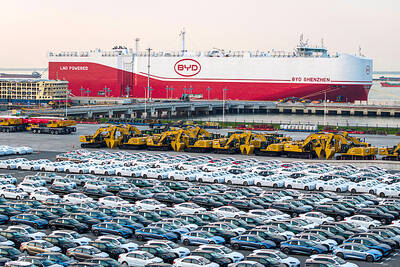Standard and Poor’s (S&P) said Japanese Prime Minister Yoshihiko Noda’s administration has not made progress in tackling the public debt burden, an indication the ratings agency could be preparing to lower the nation’s sovereign grade.
“Japan’s finances are getting worse and worse every day, every second,” Takahira Ogawa director of sovereign ratings at S&P in Singapore, said in an interview. Asked if that means he is closer to cutting Japan, he said it “may be right in saying that we’re closer to a downgrade, but the deterioration has been gradual so far, and it’s not like we’re going to move today.”
A reduction in S&P’s “AA-” rating would be a setback for Noda, who took office in September and has pledged to both steady Japan’s finances and implement reconstruction from the earthquake and tsunami in March. It is unrealistic for Japan to think it can escape the debt woes that have engulfed other nations unless it can control its finances, Ogawa said.
While Japan has enjoyed borrowing costs at global lows for its debt, the IMF said in a report released on its Web site on Wednesday that there is a risk of a “sudden spike” in yields that could make the debt level unsustainable.
S&P has had Japan on a negative outlook since April. Ogawa said the nation needs a “comprehensive approach” to containing its debt burden, which the government projects will exceed ¥1 quadrillion (US$13 trillion) in the year through March as the nation pays for reconstruction.
The yen pared gains after Ogawa’s remarks and was trading at ¥77.15 against the US dollar as of 3:23pm in Tokyo yesterday. Yields on Japan’s benchmark 10-year government bond rose to as high as 0.98 percent yesterday from the previous close of 0.965 percent, before the nation’s markets shut on Wednesday for a holiday. The Nikkei 225 Stock Average dropped 1.8 percent to 8,165.18, its lowest close since March 2009.
“The events in Europe show us that when you lose market confidence at some point, the situation deteriorates fast,” Ogawa said. “Politicians need to act with the understanding that they are running out of time” to fix the nation’s finances. “If you don’t act early, it will become even more difficult” to maintain market trust, he said.
Japan’s lower house of parliament yesterday approved legislation that would add an additional 2.1 percent levy to an individual’s annual payment. Lawmakers revised the government’s proposal to extend the period of the measure from 10 years to 25 years, to help pay for reconstruction. The measure will take effect in 2013.
“Just because this passes does not mean that it’s positive for the public finances,” Ogawa said. “Politicians are squabbling over the minute details, while avoiding what’s most important.”
While Japan’s policymakers have signaled they will double the nation’s sales tax from 5 percent by about 2015, a bill has yet to be enacted.
Moody’s Investors Service cut the nation’s debt rating by one step to “Aa3” on Aug. 24. S&P lowered Japan to “AA-” in January and Fitch Ratings also has Japan at “AA-,” with a negative outlook.

Micron Memory Taiwan Co (台灣美光), a subsidiary of US memorychip maker Micron Technology Inc, has been granted a NT$4.7 billion (US$149.5 million) subsidy under the Ministry of Economic Affairs A+ Corporate Innovation and R&D Enhancement program, the ministry said yesterday. The US memorychip maker’s program aims to back the development of high-performance and high-bandwidth memory chips with a total budget of NT$11.75 billion, the ministry said. Aside from the government funding, Micron is to inject the remaining investment of NT$7.06 billion as the company applied to participate the government’s Global Innovation Partnership Program to deepen technology cooperation, a ministry official told the

Taiwan Semiconductor Manufacturing Co (TSMC, 台積電), the world’s leading advanced chipmaker, officially began volume production of its 2-nanometer chips in the fourth quarter of this year, according to a recent update on the company’s Web site. The low-key announcement confirms that TSMC, the go-to chipmaker for artificial intelligence (AI) hardware providers Nvidia Corp and iPhone maker Apple Inc, met its original roadmap for the next-generation technology. Production is currently centered at Fab 22 in Kaohsiung, utilizing the company’s first-generation nanosheet transistor technology. The new architecture achieves “full-node strides in performance and power consumption,” TSMC said. The company described the 2nm process as

POTENTIAL demand: Tesla’s chance of reclaiming its leadership in EVs seems uncertain, but breakthrough in full self-driving could help boost sales, an analyst said Chinese auto giant BYD Co (比亞迪) is poised to surpass Tesla Inc as the world’s biggest electric vehicle (EV) company in annual sales. The two groups are expected to soon publish their final figures for this year, and based on sales data so far this year, there is almost no chance the US company led by CEO Elon Musk would retain its leadership position. As of the end of last month, BYD, which also produces hybrid vehicles, had sold 2.07 million EVs. Tesla, for its part, had sold 1.22 million by the end of September. Tesla’s September figures included a one-time boost in

Shares in Taiwan closed at a new high yesterday, the first trading day of the new year, as contract chipmaker Taiwan Semiconductor Manufacturing Co (TSMC, 台積電) continued to break records amid an artificial intelligence (AI) boom, dealers said. The TAIEX closed up 386.21 points, or 1.33 percent, at 29,349.81, with turnover totaling NT$648.844 billion (US$20.65 billion). “Judging from a stronger Taiwan dollar against the US dollar, I think foreign institutional investors returned from the holidays and brought funds into the local market,” Concord Securities Co (康和證券) analyst Kerry Huang (黃志祺) said. “Foreign investors just rebuilt their positions with TSMC as their top target,